tow HONDA ELEMENT 2003 1.G Owners Manual
[x] Cancel search | Manufacturer: HONDA, Model Year: 2003, Model line: ELEMENT, Model: HONDA ELEMENT 2003 1.GPages: 338, PDF Size: 4.08 MB
Page 1 of 338
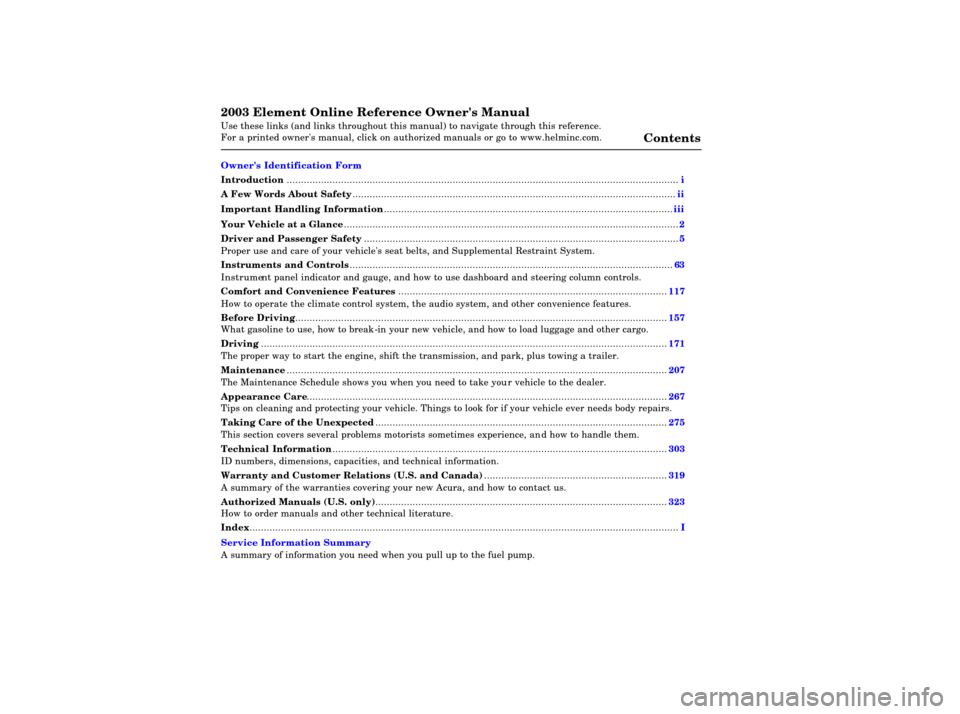
2003 Element Online Reference Owner's Manual Use these links (and links throughout this manual) to navigate through\
this reference.
For a printed owner's manual, click on authorized manuals or go to www.h\
elminc.com.
Contents
Owner's Identification Form
Introduction ........................................................................\
................................................................. i
A Few Words About Safety........................................................................\
.........................................ii
Important Handling Information........................................................................\
.............................iii
Your Vehicle at a Glance........................................................................\
.............................................2
Driver and Passenger Safety ........................................................................\
......................................5
Proper use and care of your vehicle's seat belts, and Supplemental Restr\
aint System.
Instruments and Controls........................................................................\
.........................................63
Instrume nt panel indicator and gauge, and how to use dashboard and steering colu\
mn controls.
Comfort and Convenience Features ........................................................................\
......................117
How to operate the climate control system, the audio system, and other c\
onvenience features.
Before Driving........................................................................\
..........................................................157
What gasoline to use, how to break -in your new vehicle, and how to load luggage and other cargo.
Driving ........................................................................\
......................................................................171
The proper way to start the engine, shift the transmission, and park, pl\
us towing a trailer.
Maintenance........................................................................\
.............................................................207
The Maintenance Schedule shows you when you need to take you r vehicle to the dealer.
Appearance Care........................................................................\
......................................................267
Tips on cleaning and protecting your vehicle. Things to look for if your\
vehicle ever needs body repairs.
Taking Care of the Unexpected........................................................................\
..............................275
This section covers several problems motorists sometimes experience, an d how to handle them.
Technical Information........................................................................\
.............................................303
ID numbers, dimensions, capacities, and technical information.
Warranty and Customer Relations (U.S. and Canada)................................................................319
A summary of the warranties covering your new Acura, and how to contact \
us.
Authorized Manuals (U.S. only)........................................................................\
..............................323
How to order manuals and other technical literature.
Index........................................................................\
.............................................................................. I
Service Information Summary
A summary of information you need when you pull up to the fuel pump.
Page 24 of 338
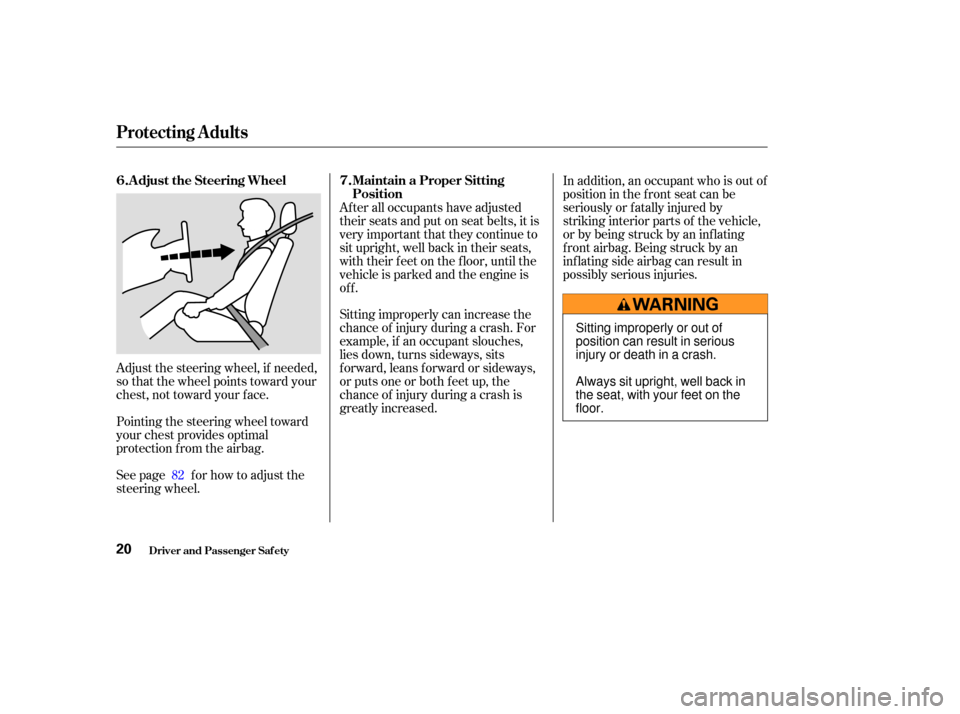
Adjust the steering wheel, if needed,
so that the wheel points toward your
chest, not toward your f ace.
Pointing the steering wheel toward
your chest provides optimal
protection f rom the airbag.
See page f or how to adjust the
steering wheel.Sitting improperly can increase the
chance of injury during a crash. For
example, if an occupant slouches,
lies down, turns sideways, sits
forward, leans forward or sideways,
or puts one or both f eet up, the
chance of injury during a crash is
greatly increased. After all occupants have adjusted
their seats and put on seat belts, it is
very important that they continue to
sit upright, well back in their seats,
with their feet on the floor, until the
vehicle is parked and the engine is
off.
In addition, an occupant who is out of
position in the f ront seat can be
seriously or f atally injured by
striking interior parts of the vehicle,
or by being struck by an inf lating
f ront airbag. Being struck by an
inf lating side airbag can result in
possibly serious injuries.
82
Driver and Passenger Saf ety
Protecting Adults
Adjust the Steering Wheel Maintain a Proper Sitting
Position
6.
7.
20
Sitting improperly or out of
position can result in serious
injury or death in a crash.
Always sit upright, well back in
the seat, with your feet on the
floor.
Page 28 of 338
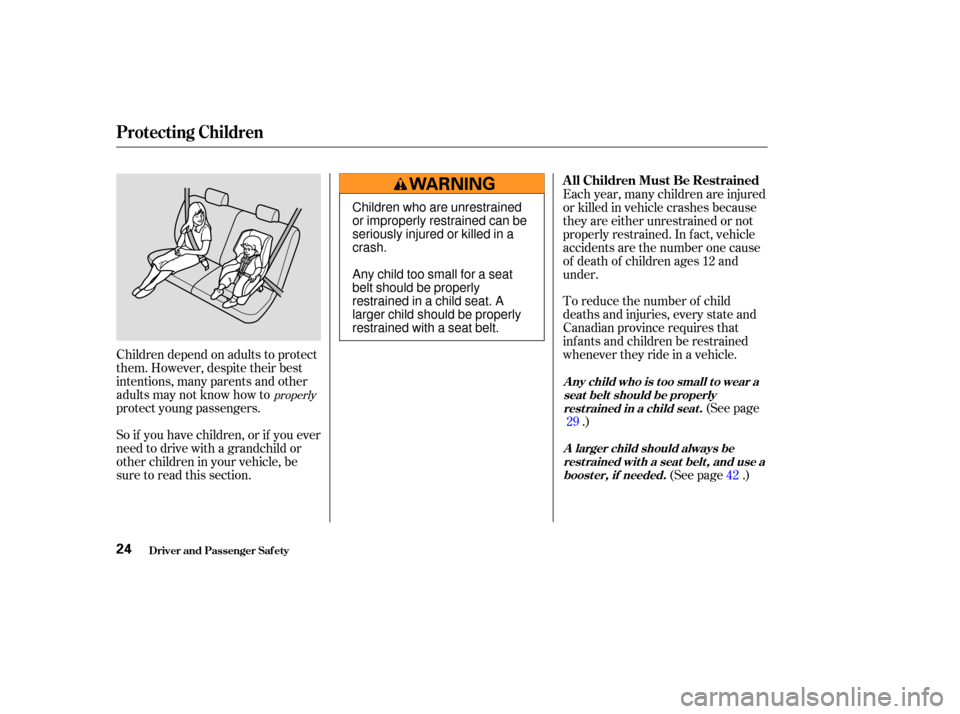
Children depend on adults to protect
them. However, despite their best
intentions, many parents and other
adults may not know how to
protect young passengers.(See page
.)
So if you have children, or if you ever
need to drive with a grandchild or
other children in your vehicle, be
sure to read this section. To reduce the number of child
deaths and injuries, every state and
Canadian province requires that
inf ants and children be restrained
whenever they ride in a vehicle. Each year, many children are injured
or killed in vehicle crashes because
they are either unrestrained or not
properly restrained. In f act, vehicle
accidents are the number one cause
of death of children ages 12 and
under.
(See page .)
29
42
properly
All Children Must Be Restrained
Anychildwhoistoosmalltowearaseat belt should be properlyrest rained in a child seat .
A larger child should always berest rained wit h a seat belt , and use aboost er, if needed.
Protecting Children
Driver and Passenger Saf ety24
Children who are unrestrained
or improperly restrained can be
seriously injured or killed in a
crash.
Any child too small for a seat
belt should be properly
restrained in a child seat. A
larger child should be properly
restrained with a seat belt.
Page 41 of 338
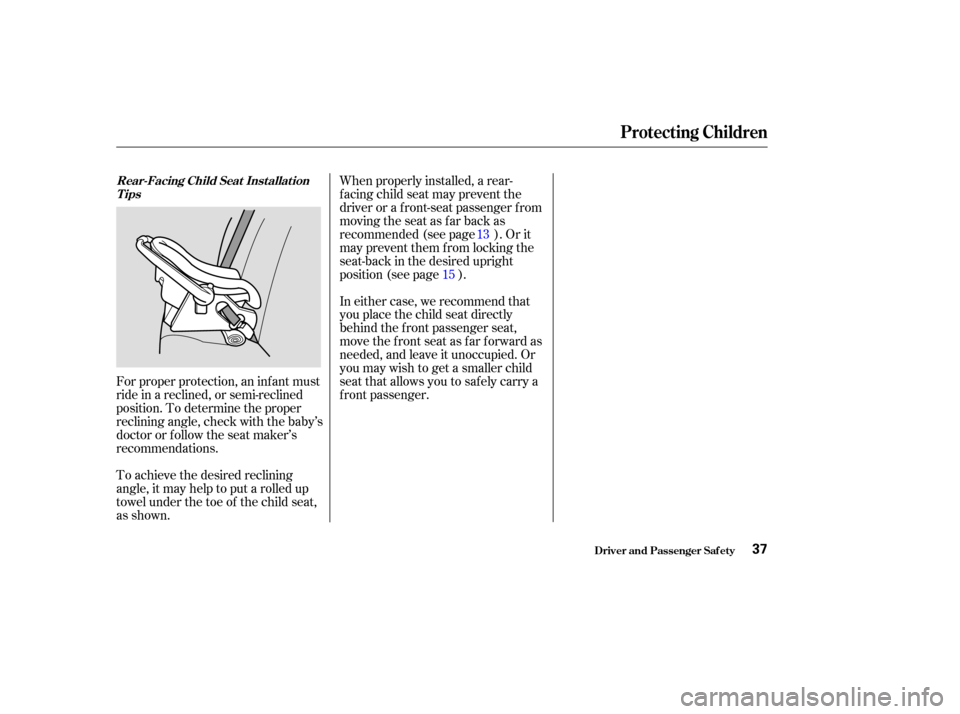
Forproperprotection,aninfantmust
ride in a reclined, or semi-reclined
position. To determine the proper
reclining angle, check with the baby’s
doctor or f ollow the seat maker’s
recommendations.
To achieve the desired reclining
angle, it may help to put a rolled up
towel under the toe of the child seat,
as shown.When properly installed, a rear-
f acing child seat may prevent the
driver or a f ront-seat passenger f rom
moving the seat as far back as
recommended (see page ). Or it
may prevent them f rom locking the
seat-back in the desired upright
position (see page ).
In either case, we recommend that
you place the child seat directly
behind the f ront passenger seat,
move the front seat as far forward as
needed, and leave it unoccupied. Or
you may wish to get a smaller child
seat that allows you to safely carry a
f ront passenger.
13
15
Protecting Children
Driver and Passenger Saf ety
Rear-Facing Child Seat Inst allat ion Tips
37
Page 49 of 338

If you decide that a child can saf ely
ride up f ront, be sure to:Caref ully read the owner’s manual
and make sure you understand all
seat belt instructions and all saf ety
inf ormation.
Move the vehicle seat to the rear-
most position.
Have the child sit up straight, back
against the seat, and feet on or
near the f loor.
Check that the child’s seat belt is
properly positioned and secured.
Physically, a child must be large
enough f or the lap/shoulder belt to
properly f it over the hips, chest, and
shoulder (see pages and ). If
the seat belt does not f it properly,
the child should not sit in the f ront.
To saf ely ride in f ront, a child must
be able to f ollow the rules, including
sitting properly and wearing the seat
belt properly throughout a ride.
On models with side airbags,
remind the child not to lean
toward the door because of the
side airbag.Supervise the child. Even mature
children sometimes need to be
reminded to f asten the seat belts
or sit properly.
17 42Physical Size
Maturity
Protecting Children
Driver and Passenger Saf ety45
Page 86 of 338
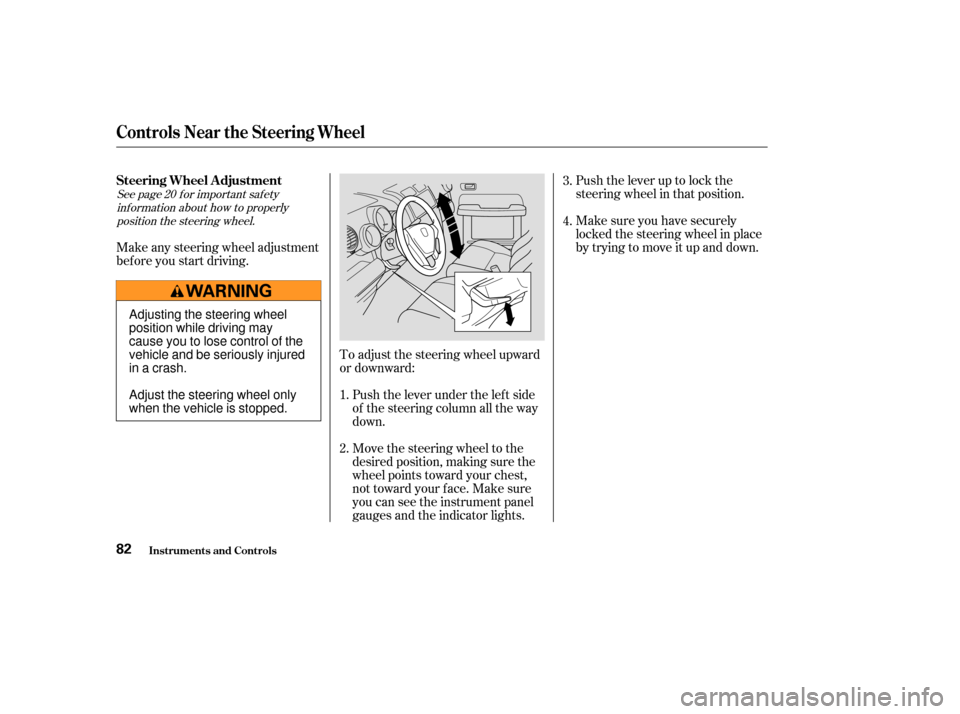
Push the lever up to lock the
steering wheel in that position.
Make sure you have securely
locked the steering wheel in place
by trying to move it up and down.
To adjust the steering wheel upward
or downward:
Make any steering wheel adjustment
bef ore you start driving.
Push the lever under the lef t side
of the steering column all the way
down.
Move the steering wheel to the
desired position, making sure the
wheel points toward your chest,
not toward your f ace. Make sure
you can see the instrument panel
gauges and the indicator lights.
1.
2. 3.
4.
See page f or important saf ety
inf ormation about how to properlyposition the steering wheel. 20
Steering Wheel A djustment
Controls Near the Steering Wheel
Inst rument s and Cont rols82
Adjusting the steering wheel
position while driving may
cause you to lose control of the
vehicle and be seriously injured
inacrash.
Adjust the steering wheel only
when the vehicle is stopped.
Page 103 of 338
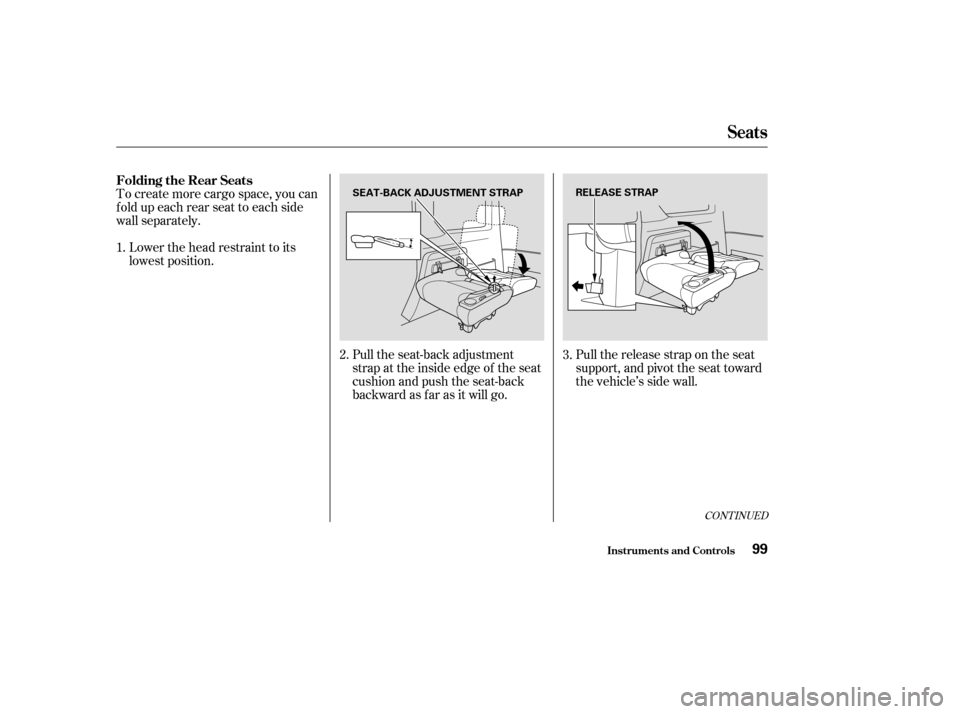
To create more cargo space, you can
fold up each rear seat to each side
wall separately.Lower the head restraint to its
lowest position.
Pull the seat-back adjustment
strap at the inside edge of the seat
cushion and push the seat-back
backward as f ar as it will go.Pull the release strap on the seat
support, and pivot the seat toward
the vehicle’s side wall.
1.
2.3.
CONT INUED
Folding the Rear Seats
Seats
Inst rument s and Cont rols99
SEAT-BACK ADJUSTMENT STRAP RELEASE STRAP
Page 104 of 338
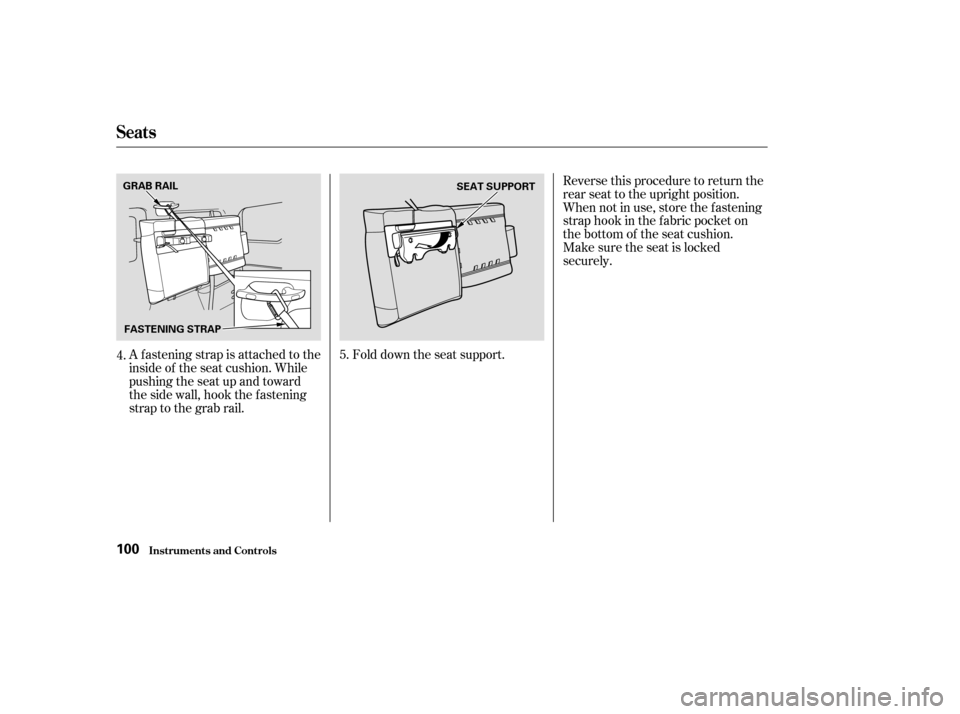
Fold down the seat support.
A fastening strap is attached to the
inside of the seat cushion. While
pushing the seat up and toward
thesidewall,hookthefastening
straptothegrabrail. Reverse this procedure to return the
rear seat to the upright position.
When not in use, store the fastening
strap hook in the f abric pocket on
the bottom of the seat cushion.
Make sure the seat is locked
securely.
4. 5.
Seats
Inst rument s and Cont rols100
GRAB RAIL
FASTENING STRAP SEAT SUPPORT
Page 109 of 338
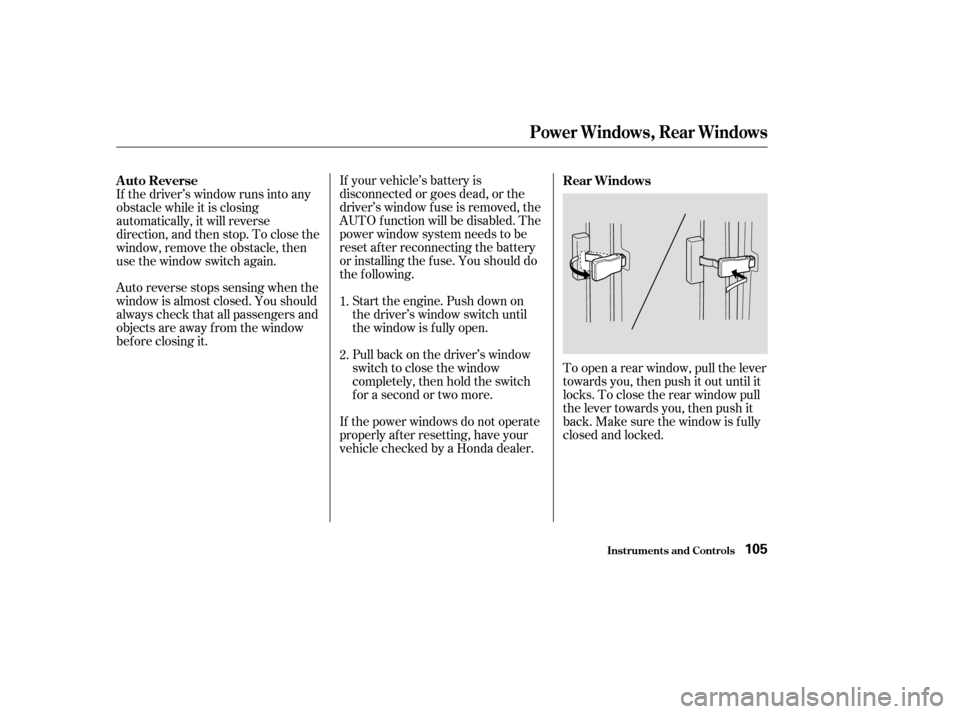
If your vehicle’s battery is
disconnected or goes dead, or the
driver’s window f use is removed, the
AUTO f unction will be disabled. The
power window system needs to be
reset af ter reconnecting the battery
or installing the f use. You should do
the f ollowing.Start the engine. Push down on
the driver’s window switch until
the window is f ully open.
Pull back on the driver’s window
switch to close the window
completely, then hold the switch
f or a second or two more.
If the power windows do not operate
properly af ter resetting, have your
vehicle checked by a Honda dealer.
Auto reverse stops sensing when the
window is almost closed. You should
always check that all passengers and
objects are away from the window
bef ore closing it. If the driver’s window runs into any
obstacle while it is closing
automatically, it will reverse
direction, and then stop. To close the
window, remove the obstacle, then
use the window switch again.
To open a rear window, pull the lever
towards you, then push it out until it
locks. To close the rear window pull
the lever towards you, then push it
back. Make sure the window is f ully
closed and locked.
1.
2.
Auto Reverse
Rear Windows
Power Windows, Rear Windows
Inst rument s and Cont rols105
Page 112 of 338

To remove the skylight:
Turn of f the engine, and set the
parkingbrake.Thenpulldownthe
lever, squeeze both sides of the pivot
while pushing up the red tab in the
lever, and pull the lever assembly
away from the ceiling.Push up the rear of the skylight.
Standing on the tailgate with the
hatch down, hold both sides of the
skylight and pull it toward you to
remove it f rom the vehicle roof .
With the rear seats in their upright
position, store the skylight, f ace
down in its bag in the cargo area.
Secure the bag with four hooks on
the cargo area f loor. Do not store
anything on top of the skylight.
Removing and Storing the
Skylight
Skylight
Inst rument s and Cont rols108
The maximum weight on the tailgate is
440 lbs (200 kg).